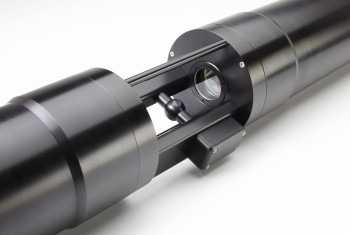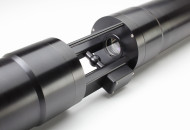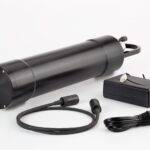Features
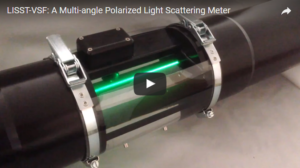 In-situ measurements of P11, P12 and P22 (noisy) elements of scattering Mueller matrix, (P11 is VSF) from 15-150º (no P22 estimate at 45 and 135°).
In-situ measurements of P11, P12 and P22 (noisy) elements of scattering Mueller matrix, (P11 is VSF) from 15-150º (no P22 estimate at 45 and 135°).- VSF (P11) only at small angles, 0.09 to 10º in 32 logarithmic steps in angles.
- Only two detectors employed with absolute radiant sensitivity (A/W) calibration.
- Beam attenuation measured with optics similar to our LISST-100X/200X.
- Roving Eyeball™ optics permit 1-degree resolution in angles between 15 -150º.
- Sampling rate at 4 seconds per measurement set (involves 2 turns of Roving Eyeball with vertical, and horizontal laser polarization).
- Daylight rejection by laser modulation.
- Dynamic range in VSF measurements extended via laser power dimming.
- Data from small and large angles in a single data stream, including depth and temperature.
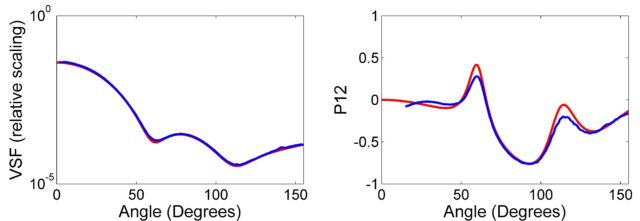
The VSF and P12 for 0.496 micron polystyrene beads, measured(blue) vs Mie theory (red).
The LISST-VSF comes with all the items necessary for deployment including a rechargeable NiMH external battery pack that allows more than 15 hours of continuous data collection. A test chamber is also provided to allow the instrument to be tested in the lab. An optional mixed test chamber with four counter rotating mixers is available for extensive laboratory testing.
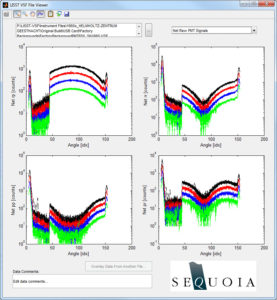
Raw LISST-VSF data viewed using the Matlab GUI
The LISST-VSF also ships with Matlab scripts that allow for both viewing raw data and for one step data processing. Raw data from the instrument is plotted using a Matlab based GUI. This piece of software is useful for conducting quick QC checks of the data or ensuring cleanliness of the instrument and/or background water.
The Matlab processing functions handle all of the calculations required to convert raw data to the calibrated Volume Scattering Function. All that is required for processing is a raw data file and a clean water background file. The processing function returns approximately 15 different computed variables, most notably:
- P11 (Volume Scattering Function)
- P12
- Noisy estimate of P22, and no P22 estimate at 45 and 135°
- Beam attenuation coefficient (c)
- Scattering coefficient (b)
- Depth
- Temperature
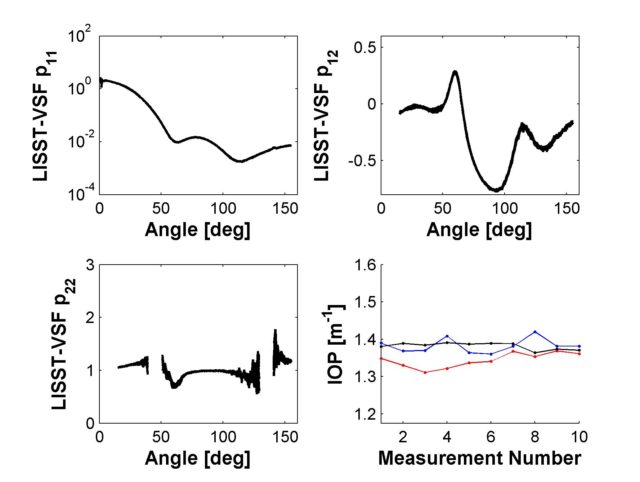
Optional data plots produced by the one step data processing function
The processing function also provides the option of plotting several of the computed data products.
All of the source code for the processing functions ship with the LISST-VSF. The code can be edited for custom applications or used as a tool to better understand the steps involved in the data processing.
See article below for more details about the LISST-VSF or click here to read the abstract.
Slade, W.H., Agrawal, Y.C. and Mikkelsen, O.A., 2013, September. Comparison of measured and theoretical scattering and polarization properties of narrow size range irregular sediment particles. In Oceans-San Diego, 2013 (pp. 1-6). IEEE. Link to Full Text

Watch a short video on the LISST-VSF below:
Video courtesy of Dr. Deric Gray, NRL.
Specifications
Parameters Measured
- Small-angle VSF in 32 log-spaced angles, from 0.1 to ~15º.
- VSF, P12 and P22 over 15-150º in 1º steps, no P22 at 45 and 135°.
- Temperature from –5º to 50ºC @ 0.1ºC resolution.
- Depth (300 m max) @ 10 cm resolution
Operating Concentration Range
- Beam attenuation coefficient from ~0.1 to ~20 m -1
Technology
- 515 nm fiber-coupled laser.
- Ring Detectors for small-angle VSF.
- Roving Eyeball and PMT for 15-150º.
Mechanical and Electrical – LISST-VSF
- Dimensions: 13.3 cm × 96 cm (5.25″ × 37.9″) [Ø × L]
- Weight: 13 kg (28 lbs) in air; 8 kg (17.5 lbs) in water
- 50 m operational and 300 m maximum depth limit
- 128 GB internal solid state drive; equivalent to 40,000 measurements
- External power input: 12 to 16 V
- Power drain: 700mA (measuring), 170mA quiescent.
Mechanical and Electrical – Battery
- Rechargeable NiMH battery, battery charger included
- Dimensions 10 cm (3.95”) diameter, 52 cm (20.65”) long including handle
- Weight: 6.5 kg (14.3 lbs]) in air; 2 kg (2.2 lb) in water
- Voltage: 14.4 V nominal; 16 V fully charged; 12 V min. operating
- Capacity: 14 Ahr, 200 Whr (enough for at least 15 hours of continuous VSF sampling)
FAQ
What does the LISST-VSF measure?
The LISST-VSF is a tool for optical oceanographers and limnologists. It measures the volume scattering function of water, the beam attenuation coefficient, and scattering coefficient. In addition, it measures the depolarization properties, P12. P22 . P22 has a ‘blind spot’ around 45 and 135-degrees.
What is P12 and P22
Any light scattering event changes the polarization state of the scattered light. Even if unpolarized light scatters off a particle, the scattered light will be partially polarized. The parameter P12 describes one of the depolarization properties of the scattering medium. P22 is an indicator of sphericity; P22=1 for spheres only. For in-depth understanding, we recommend the text: Absorption and Scattering of Light by Small Particles by C. Bohren and D. Huffman.
Does the instrument measure and record depth and temperature also?
How is power provided?
A rechargeable external power pack is included with the instrument.
What is the angular resolution in VSF
In the small forward angles, the angle spacing is logarithmic, from 0.088 to 14.3 degrees in 32 steps. Beyond that, VSF is measured at 1-deg intervals.
How long does it take to acquire one full data set?
It takes 2 full rotations of the ‘eyeball’ to capture a single set of data. This takes about 3 seconds.
What software is included?
Software is based on Matlab, and it processes the full datafile, producing VSF, P12, P22, b, c, depth and temperature.
What do I need to learn to operate the instrument?
We have greatly simplified the user interface, and it is mostly intuitive. But, we recommend that you read the short manual in any case.
How is LISST-VSF different from previous VSF sensors?
LISST-VSF has these capabilities that prior sensors did not: (1) It measures small-forward angle VSF, from 0.09-deg out to 150; (2) It measures beam-c accurately with a beam acceptance angle < 0.06-degrees. (3) It measures P12 and P22 from 15-150 degrees; (4) From the VSF, it derives an estimate of beam-scattering coefficient b. (5) It is programmable and autonomous, ready for profiling or fixed use. (6) Laboratory use is easy, with a provided sample chamber.
How does the LISST-VSF work?
This is explained in some detail here.
Can I rent the LISST-VSF?
